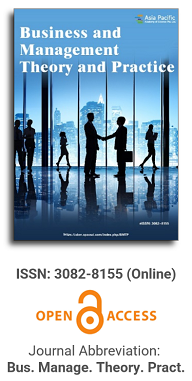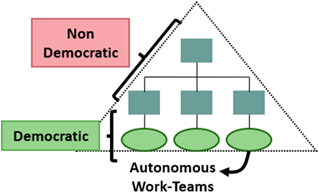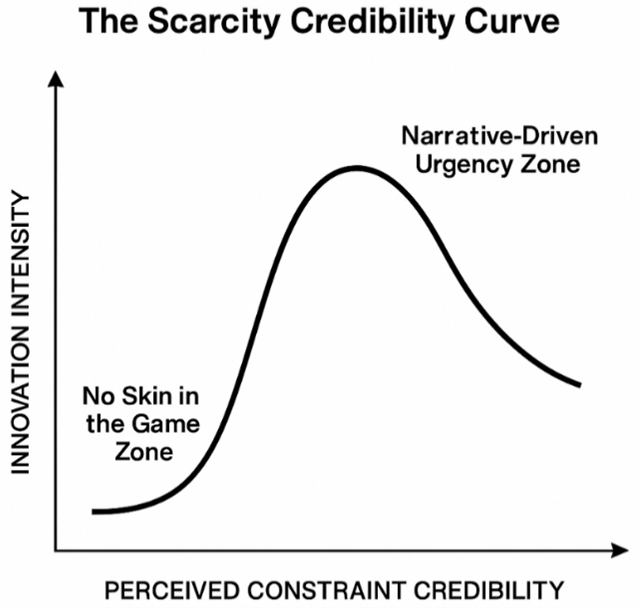
Asia Pacific Academy of Science Pte. Ltd. (APACSCI) specializes in international journal publishing. APACSCI adopts the open access publishing model and provides an important communication bridge for academic groups whose interest fields include engineering, technology, medicine, computer, mathematics, agriculture and forestry, and environment.


Beyond scarcity theater: Designing innovation systems around authentic constraints
Vol 2, Issue 2, 2025
Download PDF
Abstract
Many organizations try to spark innovation by imposing artificial constraints like tight deadlines or hackathons, hoping to replicate the ingenuity born of necessity. Yet research shows these often fall short. This article contrasts “authentic scarcity”, conditions of irreversible consequences and existential urgency, with artificially imposed constraints. Only the former reliably activates the psychological, cultural, and systemic drivers of transformative innovation. Through case studies of Mumbai’s Dharavi slum and Silicon Valley’s frugal innovation labs, we show how real constraints foster resilience and radical problem-solving, while artificial ones yield superficial creativity. We present a strategic framework for leaders to engineer purpose-driven missions with real stakes, collaborate with necessity-driven ecosystems, and cultivate high-stakes leadership. The paper concludes with a theory of authentic scarcity, explaining how genuine constraints uniquely drive breakthrough innovation by triggering focus, cohesion, and urgency, offering crucial insights for innovation management in resource-rich settings.
Keywords
References
1. Amabile TM. A model of creativity and innovation in organizations. Research in Organizational Behavior. 1988.
2. Furr N, Dyer J. The innovator’s method: bringing the lean start-up into your organization. Harvard Business Review Press; 2014.
3. Radjou N, Prabhu J, Ahuja S. Jugaad innovation: Think frugal, be flexible, generate breakthrough growth. John Wiley & Sons; 2012.
4. Taleb NN. Skin in the Game: Hidden Asymmetries in Daily Life. Random House; 2018.
5. George B. The Entropy of Knowledge (EoN): Complexity, Uncertainty, and the Quest for Scientific Knowledge. arXiv; 2024.
6. George B, Mattathil AP. Empowering African American Tourism Entrepreneurs with Generative AI: Bridging Innovation and Cultural Heritage. Societies. 2025; 15(2): 34. doi:10.3390/soc15020034
7. Baker D. The Apollo Missions: The incredible story of the race to the Moon. Arcturus Publishing; 2018.
8. Betts A, Bloom L. Humanitarian innovation: The state of the art. United Nations Office for the Coordination of Humanitarian Affairs; 2014.
9. Staw BM, Sandelands LE, Dutton JE. Threat rigidity effects in organizational behavior: A multilevel analysis. Administrative science quarterly. 1981; 501-24.
10. Shah AK, Mullainathan S, Shafir E. Some Consequences of Having Too Little. Science. 2012; 338(6107): 682-685. doi:10.1126/science.1222426
11. Mani A, Mullainathan S, Shafir E, Zhao J. Poverty Impedes Cognitive Function. Science. 2013; 341(6149): 976-980. doi:10.1126/science.1238041
12. Hicks JR. The Theory of Wages. Macmillan; 1932.
13. Acemoglu D. Technology and inequality. NBER Reporter Online; 2002.
14. Nelson RR, Winter SG. An evolutionary theory of economic change. Harvard University Press; 1982.
15. Beghetto RA. How Times of Crisis Serve as a Catalyst for Creative Action: An Agentic Perspective. Frontiers in Psychology. 2021;11. doi:10.3389/fpsyg.2020.600685
16. George B, Wooden O. Managing the Strategic Transformation of Higher Education through Artificial Intelligence. Administrative Sciences. 2023;13(9):196. doi:10.3390/admsci13090196
17. Sommer A, Pearson C. Infusing creativity into crisis management: An essential approach today. Organizational Dynamics. 2011; 40: 27-33.
18. Bhaskara GI, Filimonau V, Wijaya NMS, et al. Innovation and creativity in a time of crisis: A perspective of small tourism enterprises from an emerging destination. Tourism Management Perspectives. 2023; 46: 101093. doi: 10.1016/j.tmp.2023.101093
19. Jeong I, Gong Y, Zhong B. Does an Employee-Experienced Crisis Help or Hinder Creativity? Journal of Management. 2022; 49(4): 1394-1429. doi: 10.1177/01492063221082537
20. Broshi-Chen O, Mansfeld Y. Creativity and innovation in tourism crisis management: A QC&IM approach. Journal of Hospitality and Tourism Management. 2021; 46: 272-283. doi: 10.1016/j.jhtm.2021.01.003
21. Brem A, Nylund PA, Roshani S. Unpacking the complexities of crisis innovation: a comprehensive review of ecosystem-level responses. Review of Managerial Science. 2023; 18(8): 2441-2464. doi: 10.1007/s11846-023-00709-x
22. Smaliukienė R. Creativity in crisis communication: a systematic review. Creativity Studies. 2024; 17(2): 548-570. doi:10.3846/cs.2024.20061
23. Baer M, Oldham GR. The curvilinear relation between experienced creative time pressure and creativity. Journal of Applied Psychology. 2006; 91(4): 963-970. doi: 10.1037/0021-9010.91.4.963
24. Rosso BD. Creativity and constraints: Exploring the role of constraints in R&D teams. Organization Studies. 2014; 35(4): 551-585.
25. Gilson LL, Mathieu JE, Shalley CE, Ruddy TM. Creativity and Standardization: Complementary or Conflicting Drivers. Academy of Management Journal. 2005;48(3):521-531. doi:10.5465/amj.2005.17407916
26. Almarzouki AF. Stress, working memory, and academic performance. Stress. 2024; 27(1). doi: 10.1080/10253890.2024.2364333
27. Lupien SJ, Maheu F, Tu M, et al. The effects of stress on human cognition. Brain and Cognition. 2007; 65(3): 209-237. doi: 10.1016/j.bandc.2007.02.007
28. Godoy LD, Rossignoli MT, Delfino-Pereira P, et al. A Comprehensive Overview on Stress Neurobiology. Frontiers in Behavioral Neuroscience. 2018; 12. doi: 10.3389/fnbeh.2018.00127
29. Sanders A. Towards a model of stress and human performance. Acta Psychologica. 1983; 53(1): 61-97. doi: 10.1016/0001-6918(83)90016-1
30. McEwen BS. The Brain on Stress. Perspectives on Psychological Science. 2013; 8(6): 673-675. doi: 10.1177/1745691613506907
31. Guo H, Zheng L, Xu H, et al. Neurobiological Links between Stress, Brain Injury, and Disease. Oxidative Medicine and Cellular Longevity. 2022; 2022(1). doi: 10.1155/2022/8111022
32. McEwen BS, Akil H. Revisiting the Stress Concept. The Journal of Neuroscience. 2020; 40(1): 12-21. doi:10.1523/jneurosci.0733-19.2019
33. Mandrick K, Peysakhovich V, Rémy F, et al. Human performance under stress and high mental workload. Biological Psychology. 2016; 121: 62-73. doi: 10.1016/j.biopsycho.2016.10.002
34. Gemmert V, Vangalen G. Stress, neuromotor noise, and human performance. Journal of Experimental Psychology. 1997; 23: 1299-1313. doi: 10.1037//0096-1523.23.5.1299
35. Chase MA. Stemming the tide of work-related stress. Development and Learning in Organizations. 2019; 33(4): 16-19. doi:10.1108/dlo-09-2018-0123
36. Arunga HJ. Unpacking Organizational Adaptation Strategies: A Conceptual Review. IJRISS. 2023; 7(11): 387-398. doi:10.47772/ijriss.2023.7011030
37. George B. AI Solutions for Sustainable Agricultural Supply Chains. Agriculture and Biology. 2025. doi: 10.70737/z3rm3z39
38. Kihlander I, Magnusson M, Karlsson M. Critical Factors to Consider in Innovation Management. Research-Technology Management. 2024; 67(3): 34-43. doi:10.1080/08956308.2024.2323893
39. Radosevich R. Designing innovative systems. Long Range Planning. 1977; 10(2): 79-84. doi: 10.1016/0024-6301(77)90124-8
40. Chang CS. Relationships of Organizational Justice and Organizational Constraints with Performance. [Meta-analysis]. Available online: https://etd.ohiolink.edu/acprod/odb_etd/ws/send_file/send?accession=bgsu1429212007&disposition=inline (accessed on 10 April 2025).
41. Gottfredson MR, Hirschi T. A General Theory of Crime. Stanford University Press; 1990. doi: 10.1515/9781503621794
42. Heath C, Heath D. Switch: How to Change Things When Change Is Hard. Broadway Business; 2010.
43. Christensen CM, Raynor ME, McDonald R. Disruptive innovation. Harvard Business Review; 2015.
44. Hofstede G. Culture’s consequences: Comparing values, behaviors, institutions and organizations across nations. Sage; 2001.
45. Pfeffer J, Salancik G. External control of organizations, resource dependence perspective. Routledge; 2015.
46. Deci EL, Ryan RM. Intrinsic motivation and self-determination in human behavior. Springer; 2013.
47. Roy A. Slumdog Cities: Rethinking Subaltern Urbanism. International Journal of Urban and Regional Research. 2011; 35(2): 223-238. doi: 10.1111/j.1468-2427.2011.01051.x
48. Kennedy D, Zerdin M. Waste management and microeconomies in slum environments. Journal of Urban Research. 2018; 35(3): 234-246. doi: 10.1080/jur.2018.2345
49. London T, Hart SL. Next generation business strategies for the base of the pyramid. FT Press; 2011.
50. Grant AM, Ashford SJ. The dynamics of proactivity at work. Research in Organizational Behavior. 2008; 28: 3-34. doi: 10.1016/j.riob.2008.04.002
51. Vance A, Musk E. Elon Musk: Tesla, SpaceX, and the quest for a fantastic future. Harper Collins; 2015.
52. Heifetz R, Linsky M. Leadership on the line. Harvard Business Press; 2002.
53. Hamel G, Välikangas L. The quest for resilience. Harvard Business Review; 2003.
54. Miller D. The Apollo missions: The incredible story of the race to the moon. Arcturus Publishing; 2009.
55. Waddock S, McIntosh M. SEE change: Making the transition to a sustainable enterprise economy. Routledge; 2017.
56. Dávid LD, Dadkhah M. Artificial intelligence in the tourism sector. Equilibrium Quarterly Journal of Economics and Economic Policy. 2023; 18(3): 609-613. doi: 10.24136/eq.2023.019
Supporting Agencies
Copyright (c) 2025 Author(s)
License URL: https://creativecommons.org/licenses/by/4.0/

This site is licensed under a Creative Commons Attribution 4.0 International License (CC BY 4.0).

Macau University of Science and Technology, Macau




.jpg)
.jpg)
